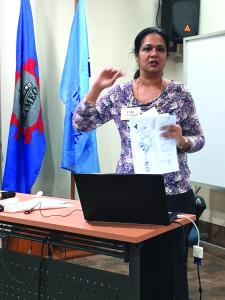Why Singapore’s English Teachers Should Embrace Singlish, Not Fight It
Is it time for Singaporean educators to embrace Singlish as a legitimate learning tool? What the Research […]
Read More

The terms blended and hybrid learning can be used interchangeably. Offline learning refers to the traditional face-to-face (f2f) instruction in a classroom setting, while online learning refers to using technology or a system over the Internet or Intranet. It is essential that the f2f component and the technology-driven element complement, strengthen and harmoniously balance each other.
Blended learning has become more significant than ever before, especially as COVID-19 becomes endemic. Home-based learning (HBL), as a blended learning model, has particularly gained importance in the Singapore education system. Recently, the Ministry of Education (MOE) announced that all secondary schools, junior colleges and Millennia Institute will systematically incorporate this model by the year 2022.
Blended learning has been accepted as an approach to ensure continuity in learning without disruptions, as well as to contribute to the building of resilience in the education system in a post COVID-19 world. Blended learning can cultivate self-regulation skills and technological competence in students, while also offering a customized learning experience. Concurrently, teacher training is critical to ensuring effective implementation of the blended learning model. At the National Institute of Education, we have researchers from OER’s Centre for Research in Pedagogy and Practice (CRPP) who have conducted workshops and ran projects in this area.
The Student Learning Space (SLS), rolled out by MOE prior to the pandemic, is a system that supports this model and has a range of resources for teaching and learning as well as lesson preparation and assessment tools for teachers. The overall idea is to ensure an experience that blends the “ingredients” collectively to deliver a meaningful, personalized and flexible learning experience. The fully online experience, after all, lacks an irreplaceable human component in which teachers offer empathy and an invaluable human connection.
This blended learning model is here to stay as we learn to live and work with an endemic COVID-19. A few foundational life skills like time management, motivation and persistence need to be nurtured in students, as they learn to have a sense of control over their time, place and pace of learning. As the New York Times columnist Thomas Friedman recently wrote: “The most critical role for K-12 educators, therefore, will be to equip young people with the curiosity and passion to be lifelong learners who feel ownership over their education.”
In this issue of SingTeach, we explore articles that discuss pertinent issues around the implementation of blended learning, with examples, experiences, perspectives and challenges associated with it. As a leader and school staff developer, Mr Luis Lioe reflects on the benefits he sees with the blended modes of learning, raising issues around mindset shifts and key considerations based on his practical experience. Dr Tay Lee Yong, a former teacher, school leader and now Teaching Fellow at CRPP is optimistic on the potential of technology and how it has shaped teaching and learning, underscoring the importance of learner engagement in blended learning. Associate Professor Chen Wenli, meanwhile, shares her experience from one of her technology projects, highlighting an important point about how technology is a tool that needs to be used meaningfully, and how lesson designers are key to a successful blended learning lesson.